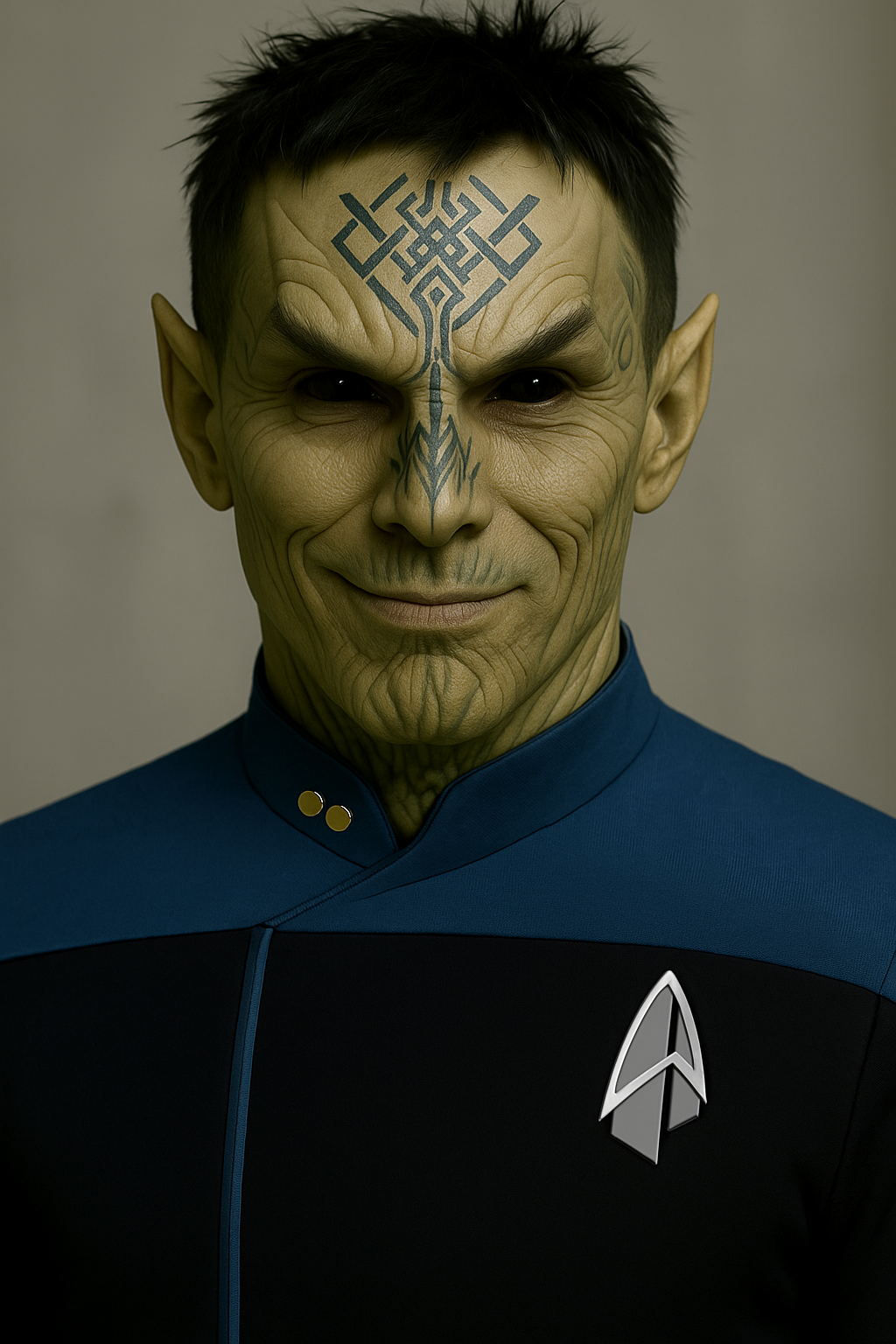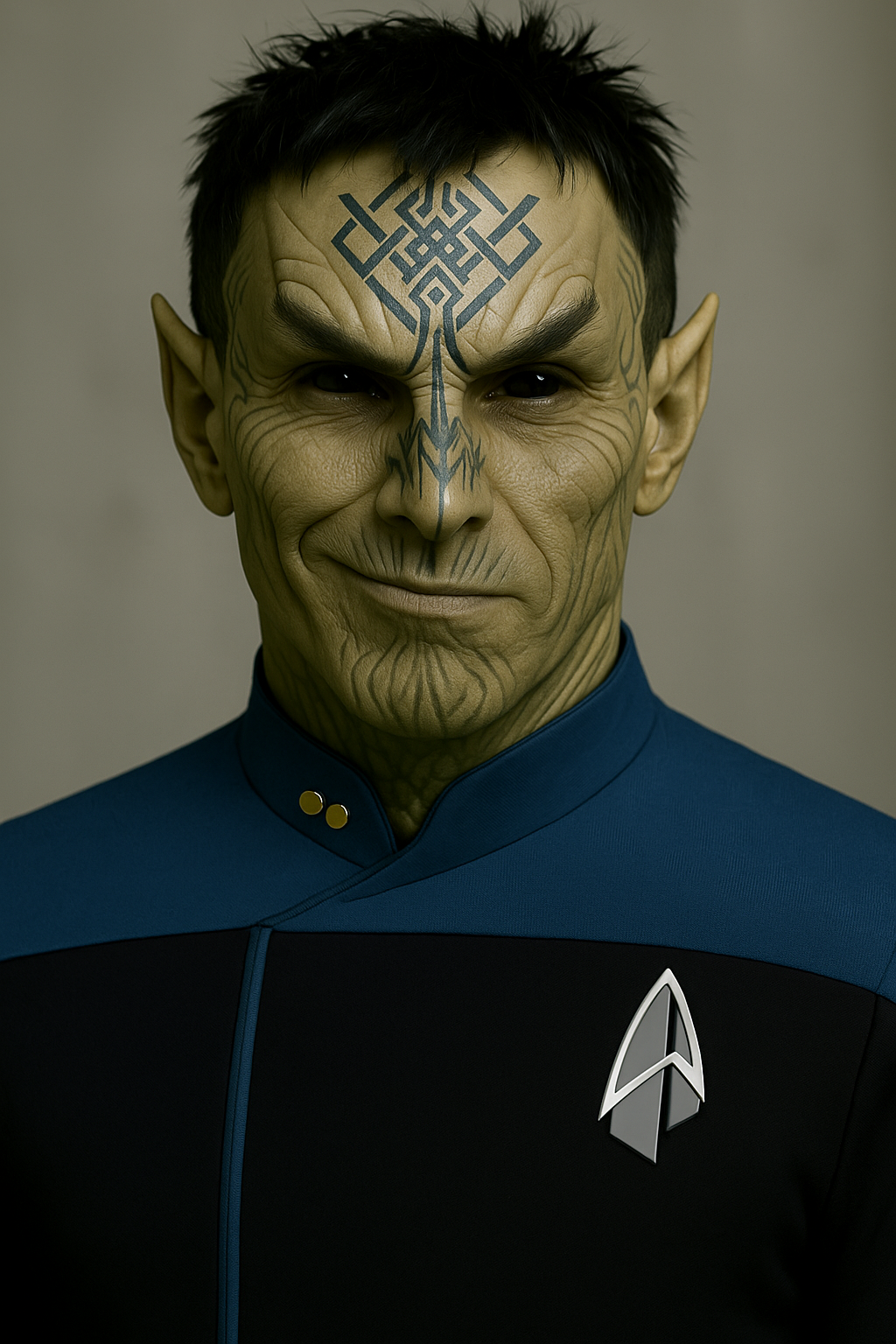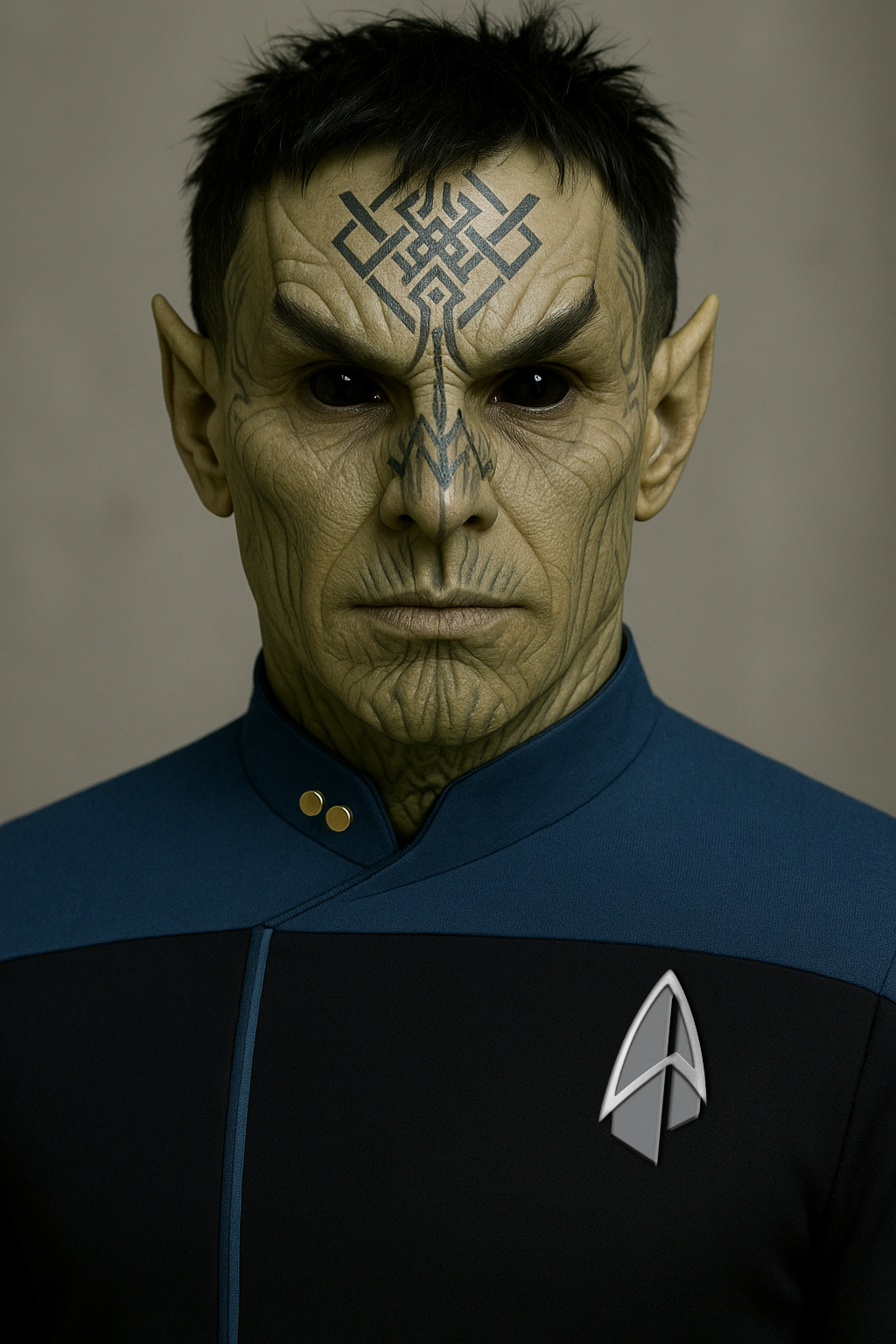Lieutenant Amarok tr'Ragnar
Name Amarok tr'Ragnar
Position Chief Science Officer
Rank Lieutenant
Stats
- 3 Mission Posts
Last Post
Thu Nov 20th, 2025 @ 5:48pm
Character Information
| Gender | Male | |
| Species | Half Romulan/Half Reman | |
| Birthplace | Hidden safehouse, outskirts of Ki Baratan, Romulus | |
| Age | 40 |
Physical Appearance
| Height | 175 cm (5’9”) | |
| Weight | 88 kg (195 lbs) | |
| Hair Color | Black | |
| Eye Color | Black | |
| Physical Description | Ash-olive with a faint metallic undertone skin. Amarok’s compact frame carries the dense musculature typical of Reman ancestry, tempered by Romulan grace. His eyes are entirely black and highly reflective, adapted to low light but sensitive to harsh glare. He keeps his hair deliberately untidy, masking faint temple ridges that hint at his hybrid genetics. A geometric memorial tattoo spans his forehead—Romulan line-work interlaced with three Reman glyphs symbolizing Memory, Vigilance, and Debt. Several small scars and faded training marks cross his arms and ribs, remnants of a youth spent on the run and in struggle. |
Family
| Father | Name redacted – Tal Shiar operative (KIA 2371) (Reman who served the Tal Shiar in some capacity.) | |
| Mother | Name redacted – Tal Shiar operative (KIA 2371) (Romulan) |
Important Relationships
| Friendships | Rafe Jaesan – former Starfleet Intelligence officer, early mentor and lover Captain Hannok Solomon – freighter unjoined Trill captain, long-term confidant |
Personality & Traits
| General Overview | Amarok projects a quiet equilibrium—an intentional calm cultivated after a childhood spent anticipating violence. Conditioned by Tal Shiar handlers and parents to observe without being seen, he remains a master of controlled presence: able to fade into a crowd or command attention when required. The freighter years on Unstable Unicorn thawed his suspicion; he learned laughter, games, and the concept of “enough.” Yet the old instincts never truly left. Sudden noises or glaring lights can trigger momentary startle responses. He manages this with disciplined breathing and a preference for dimly lit laboratories. He keeps his quarters dim, uses low-light meditation to centre himself, plays chess against himself or the computer to drain residual adrenaline, and swims whenever possible to reset sensory equilibrium. In leadership, he is patient, mentoring junior scientists with steady, understated humour. He believes science is a moral act: every repaired ecosystem or rediscovered species is an answer to the cruelty of his upbringing. |
|
| Strengths & Weaknesses | Strengths: Rapid analytical adaptation, cross-disciplinary reasoning, empathic leadership, low-light operations. Languages: Romulan (formal & street dialects), Reman trade-jargon, Federation Standard, Klingon, Andorian, Vulcan, Orion pidgin. Weaknesses: Residual mistrust under stress, tendency to over-extend compassion, wears shades for his photophobia where light levels must remain high, limited tolerance for bureaucracy. |
|
| Ambitions | To explore and protect living worlds—learning how life adapts to adversity, and ensuring no culture or ecosystem endures the kind of erasure he witnessed on Romulus. He aims to integrate biological, ecological, and anthropological research into a unified approach to frontier science. Each discovery is both atonement and renewal. | |
| Hobbies & Interests | See General Overview. |
History
| Personal History | Born in secrecy to two Tal Shiar operatives who broke protocol by falling in love, Amarok’s existence was hidden from the secret police. For ten years he lived within a covert compound where children of agents were trained in languages, observation, and silent endurance. When the Tal Shiar uncovered the site in 2371, both his parents died covering the children’s escape. Resettled on Nimbus III, Amarok spent adolescence amid the decaying “Colony of Peace.” He became fluent in multiple tongues and mechanically adept, repairing anything that kept food or shelter flowing. At sixteen, he discovered both attraction and manipulation—seduced and coerced by syndicate handlers who exploited his skills. Survival required pragmatism; empathy survived only in small acts of kindness toward other street youths. At nineteen, he met Rafe Jaesan, a covert Starfleet Intelligence operative posing as a trader. Their partnership—romantic and strategic—targeted the Orion syndicate that controlled Paradise City. Their plan succeeded only partially: Amarok was captured during the final strike, while Rafe escaped. A year of torture followed before Amarok engineered his own escape by stowing away aboard the Romulan freighter Unstable Unicorn, commanded by Hannok Solomon, an unjoined Trill. Freighter life transformed him. Among smugglers, merchants, and relief workers he discovered culture, humour, and play. During the Dominion War, the Unstable Unicorn delivered aid to war-torn worlds, exposing Amarok to devastated ecosystems and fragile colonies. The sight of poisoned seas and scorched forests replaced vengeance with curiosity. When the war ended, he vowed to learn the sciences of restoration. With support from Rafe and Hannok, Amarok entered the Daystrom Institute’s training division (2385–2388), studying xenobiology, planetary ecology, and exobiochemistry. 2387 saw the Hobus supernova caused the destruction of Romulus and Remus along with much of the Romulan Star Empire; Amarok was on Earth when it happened. He long since renounced Romulus and Remus has his home along with caring for his peoples since his parents' death before his arrival on Earth. His aptitude led to Starfleet sponsorship and, eventually, the Academy (2388–2391) where he majored in Xenobiology and Planetary Ecology and minored in Exo-anthropology and Linguistics. Peers found him distant at first but dependable under pressure. A cadet research cruise in the Deneb Expanse confirmed his natural leadership in field work. Upon graduation, he joined the USS Olympia (Nova-class) as a science officer, researching biosphere recovery and sustainable hydroponic systems for post-war colonies. His ability to read both data and people made him invaluable in delicate planetary negotiations, though he preferred soil samples to politics. He earned a promotion to Lieutenant Junior Grade. Federation Science Council enacted the Multi-Sector Reclamation Initiative (2397–2400), the Daystrom Institute's Ecological and Terraforming Division lead the mission of post-war planetary surveys and ecological viability assessments with some Starfleet research teams assisted in evaluating worlds once scheduled for rejuvenation before the Dominion War. Amarok was assigned to the Initiative Survey Team to conduct long-term biosphere monitoring and ecological restoration analyses on worlds recovering from prior industrial collapse. The quiet rhythm of fieldwork suited him—his reports precise, his reflections private—as he turned observation itself into a kind of peace as the years went by. First up was the Argolis Sector (2397) and the worlds: Tagra IV, Gamma Ceti III, Vox Sola IV that they studied and monitored post-industrial atmospheric restoration and catalogue extremophile biospheres across the Argolis sector. Their main objectives were to determine feasibility of full-scale planetary reclamation for Federation re-settlement and ecological study. Amarok had the role of field xenobiologist overseeing microbial regrowth programs and oxygenation biomes. His resilience under heavy contamination protocols earned commendation from senior Daystrom climatologists. The Kaleb Sector followed, (2398) where they went to the worlds: Caleb IV, Vendor III, Yadalla Prime to evaluate radiation residuals and biosphere recovery on worlds once scarred by Klingon and Cardassian border conflicts. Assessed long-term stability of atmospheres and potential for partial terraforming were the objectives, and Amarok was lead analyst for soil-microbiome revitalization and radiation-tolerant flora trials. His neutrality and calm disposition eased tensions among Klingon liaison officers and Federation scientists to the point where mission logs highlighted his scientific diplomacy. Risa Sector and the ecological survey loop (2399–2400) followed at the worlds: Risa system, Pyris III, Preenos IV, Retellia Prime, Paraaga II. The team conducted follow-ups of marginally habitable worlds within the Risa Sector flagged for limited terraforming. They even went as far as attempted to re-establish environmental baselines and while the team identify planets suitable for sustainable outposts or research colonies. Amarok had become principal xenobiologist and planetary-ecology liaison coordinating survey detachments while partaking in the survey work as well. He noted and documented previously unrecorded planktonic species in Preenos IV’s equatorial seas, along with re-wrote the renewal protocols later cited in Federation terraforming ethics reports. Following completion of orbital data analysis, the team received six days’ shore leave on Risa (Epsilon Ceti B II). Amarok, uncomfortable with open indulgence, spent most of it exploring underwater caves and bioluminescent reefs—his version of rest. In 2400, Amarok accepted a posting as Chief Science Officer aboard a Delta Quadrant exploratory starship, with a promotion to full Lieutenant. There he applies his expertise in xenobiology and planetary ecology to chart new worlds, ensuring exploration remains an act of preservation, not exploitation. |
Service Record
| Service Record | 2385 – 2388 Daystrom Institute (Training Division) Apprentice Researcher Xenobiology, Ecology, Exobiochemistry studies 2388 – 2391 Starfleet Academy Cadet – Science Division Majors: Xenobiology, Planetary Ecology 2391 – 2394 USS Olympia (Nova-class) Science Officer Biosphere recovery, colony support 2397 – 2400 Federation Science Council / Daystrom Institute's Ecological and Terraforming Division Field Teams Field Xenobiologist, Lead Analyst, Principal Xenobiologist and Planetary-Ecology Liaison Multi-Sector Reclamation Initiative Present USS Sojourner (Rhode Island-class) Chief Science Officer Planetary survey and life-system analysis |


